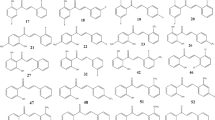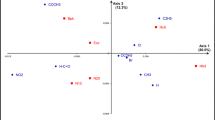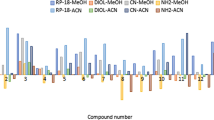Abstract
The chromatographic properties for nine antipsychotic drugs: chlorpromazine, chlorprothixene, clozapine, quetiapine, perazine, perphenazine, prochlorperazine, promazine and trifluoperazine were studied using planar chromatography. Both C18-bonded silica gel and diol-bonded phase were used as stationary phases. Mixtures of methanol–water and tetrahydrofuran–water were investigated as mobile phases. Molecular descriptors were calculated using HyperChem, ChemAxon and ACD/labs software. The study was based on multiple linear regression and the results were presented as quantitative structure–retention relationships equations. Furthermore, both principal component and cluster analysis were performed. The classification methods showed clear differences between calculated and chromatographic established lipophilicity. Chromatographic parameters were similar to bulkiness-related, geometrical descriptors and topological indexes. On the other hand, the electronic descriptors which were strongly connected with the computational log P values had lower impact on chromatographic parameters.
Similar content being viewed by others
Avoid common mistakes on your manuscript.
Introduction
In the early stages of drug development process, physicochemical properties of each drug candidates such as solubility, lipophilicity, stability and acid–base character should be determined. Lipophilicity is a vital physicochemical descriptor which influences molecule transport through biological membranes. As consequences, lipophilicity determines compound absorption, distribution, and excretion processes in the body [1].
Traditionally, to measure molecule’s lipophilicity the “shake flask” method was used, which is based on partition coefficient of target compound between n-octanol and water. However, this method has significant limitations: it is laborious, time-consuming and demanding. Consequently, indirect methods for lipophilicity determination such as chromatographic and electrometric techniques are more likely to be used. In case of chromatographic techniques, a thin layer chromatography (TLC) is considered as promising tool for lipophilicity determination. TLC method offers noticeable benefits like simplicity, rapid analysis and cheap implementation. What is more, TLC method requires small amounts of analyzed samples which do not have to be characterized by high purity because the existing impurities are separated during the chromatographic process. Additionally, TLC method is easily accessible and does not require expensive equipment [2, 3].
The quantitative structure–retention relationship (QSRR) approach was introduced for chromatographic research by Kaliszan [4, 5]. Since that time, the QSRR has been evolving into a powerful theoretical tool for the description and prediction of molecular systems in chromatographic research. It should be noted that the QSRR approach can also be applied not only for prediction of chromatographic retention parameters, but also for the evaluation of complex physicochemical properties of analytes other than chromatographic properties, e.g., lipophilicity [6,7,8,9].
Antipsychotic drugs belong to the group, where observed therapeutic effects for many patients are still unsatisfying. Moreover, the side effect characteristics for this group are often persistent and contribute to discontinuation of pharmacotherapy by patients. For these reasons, the development of new antipsychotic drugs especially which act on both positive and negative symptoms is necessary [10]. One of the main limitations for the development of new antipsychotic drugs is the naturally occurring blood–brain barrier (BBB). Each molecule which targets a receptor in the brain must be transported across the BBB. Several studies indicated that for drugs acting on central nervous system (CNS) the lipophilicity is one their crucial properties, that is why this physicochemical descriptor plays a vital role in overcoming the BBB limitations [11, 12].
The main objectives of the present study were both the determination of the lipophilicity for selected antipsychotic drugs in RP-TLC systems and comparison of the experimental chromatographic parameters with calculated molecular descriptors. The presented study is based on multiple linear regression (MLR) and multivariate analyses such as principal component analysis (PCA) and cluster analysis (CA). This work is a continuation of our previous research about chromatographic behavior of antipsychotic drugs, which was focusing on NP-TLC [13]. .
Experimental
Analytes
The nine reference antipsychotic drugs (chlorpromazine, chlorprothixene, clozapine, quetiapine, perazine, perphenazine, prochlorperazine, promazine, trifluoperazine) were chosen for the study and were purchased from Sigma-Aldrich (Steinheim, Germany), apart from perazine, which was obtained from BOC Sciences (Shirley, USA). Each substance was dissolved in HPLC-grade methanol (Sigma-Aldrich, Gillingham, Dorset, UK) to obtain nine stock solutions with drug concentration of 1 mg/mL. Obtained solutions were stored at 2–8 °C between the analyses.
Mobile and stationary phases
Chromatographic analysis was performed on commercially available C18 WF254s HPTLC and diol F254s HPTLC plates manufactured by Merck (Darmstadt, Germany) with F254 fluorescence indicator. The organic solvents (HPLC-grade: methanol and tetrahydrofuran) were supplied by Sigma-Aldrich (Gillingham, Dorset, UK). Before each chromatographic analysis, water was purified using Millipore Direct-Q 3 UV Water Purification System (Millipore Corporation, Bedford, MA, USA). The mobile phases were prepared by mixing appropriate quantities of pure organic solvents and water in proportion listed below:
-
(a)
methanol–water ranging from 50 to 100% (v/v), and tetrahydrofuran–water ranging from 30 to 80% (v/v) for C18 plates;
-
(b)
methanol–water ranging from 0 to 80% (v/v) for diol plates.
Chromatographic analysis
Cylindrical glass chambers from PoCH (Gliwice, Poland), 70 mm wide and 110 mm high, were used to develop the plates. The chromatographic chambers were saturated for 20 min before analysis. 5 µL of the drugs stock solutions (1 mg/mL) were spotted on the plates using micropipette brand (Wertheim, Germany). Chromatograms were developed to the distance of 8 cm by the ascending technique at ambient temperature (20 ± 2 °C). The investigated substances were visualized by exposing the plates to iodine vapor. The chromatographic analyses were performed in triplicate and mean Rf (retardation factor) values were calculated as follows:
where a is the distance from the origin to the spot center and b is the distance from the origin to mobile phase front. The RM value characterizing the retention in TLC was defined by Bate-Smith and Westall through the following formula:
Soczewiński–Wachtmeister equation was used to describe the linear relationship between the RM values and concentrations of the organic solvent in the mobile phase:
where RM0 in Eq. 3 represents the extrapolated RM values to zero organic modifier and m value represents specific hydrophilic surface area of the compound. The volume fraction of the organic solvent in the mobile phase is characterized by C values [14].
Molecular parameters
The simplified molecular input line entry specification (SMILES) notation was used to generate the “hin” file format of tested compounds with of the OpenBabel 2.3.3 software [15]. The calculations were carried out by HyperChem 8.08 software with ChemPlus Extension (Hypercube, Waterloo, Canada). In the first step, the chemical structures were optimized using the molecular mechanics calculations (MM+) to reduce time of further calculations. In the second step, semi-empirical calculation method Austin Model 1 (AM1) was implemented. Finally, the molecular bulkiness-related descriptors and electronic (molecular polarity-related) descriptors were obtained after the calculations. The geometrical descriptors and topological indexes were calculated with the use of ChemAxon software [16]. The number of hydrogen donors and acceptors were found in the PubChem database [17]. Furthermore, ACD/labs software was used to calculate both ACD/LogP and ACD/log D values. Highly correlated pairs of descriptors were excluded from the analysis. Finally, the 37 descriptors were chosen (Tables 1, 2).
Data analysis
All calculations were performed using STATISTICA 9.1 (StatSoft, Tulsa, Oklahoma, USA). The correlations between molecular parameters and chromatographic retention were presented as QSRR equations. To establish a QSRR equation, multiple linear regression (MLR) was derived using stepwise regression. During calculation, the chromatographic retention data (RM0) were used as dependent variable and structural parameters as the independent ones. To evaluate if the structural parameters in MLR models are independent, a correlation check was performed. The coefficient of correlation (r) and determination (R2), F test value, standard deviation and the standard estimation error were used as the basis for testing the linearity of regression plots. All presented linearity were performed at a significance level less than 5%. Principal component analysis (PCA), and cluster analysis (CA) were performed for databases which included the obtained chromatographic data and the molecular parameters. Before analysis, data were standardized to eliminate the impact of different scales by using Z-score scaling algorithm (V = mean of V/δ, where V is the value of variables and δ is the standard deviation). The missing chromatographic parameters have been replaced by mean value. CA has been carried out using Ward’s amalgamation rule and the Euclidian distance measure.
Results and discussion
The antipsychotic drugs, with well-known pharmacological and toxicological profiles, were used as a model set. All drug substances used during the study belong to the same antipsychotic class (N05A) in the Anatomical Therapeutic Chemical (ATC) classification system. In chemical point of view, there are phenothiazines derivatives with aliphatic side-chain (chlorpromazine, promazine) and with piperazine structure (perphenazine, prochlorperazine, trifluoperazine, perazine), dibenzodiazepine (clozapine), dibenzothiazepine derivative (quetiapine) and thioxanthene derivative (chlorprothixene). The chemical structures of investigated drugs are presented in Fig. 1.
The Soczewiński–Wachtmeister’s equation presented a linear relationship between the RM value and the concentration of the organic modifier in the mobile phase. Successful investigation of Soczewiński–Wachtmeister’s equation to model chromatographic behavior of antipsychotic drugs was proposed by Hawrył and coworkers [18]. In the preliminary study, a full concentration range of organic modifier (from 0 to 100%) in each of the mobile phases was examined (data not shown). However, when tetrahydrofuran as organic modifier and diol stationary phases were applied, the Soczewiński–Wachtmeister’s equation does not describe chromatographic behavior of the tested drugs. For other tested chromatographic systems, the investigated relationships were linear and the results obtained are summarized in Table 3. Generally, when the C18 bonded plates were used, regardless of investigated mobile phase, the Soczewiński–Wachtmeister’s equation presented proper chromatographic behavior of drugs. The high value of correlation coefficient (r > 0.945) confirmed this finding. In the case of chromatographic system which contained diol plates and methanol‒water mixtures as mobile phase, the non-linear relationship between the concentration of the organic modifier and the RM value was observed only for perphenazine. For all other tested drugs the relationships were linear (r > 0.949). Similar results were reported in case of our previous NP-TLC investigation [13]. These findings suggest that Soczewiński–Wachtmeister’s equation can be applied for description of chromatographic behavior of antipsychotic drugs in presented RP-TLC systems as well as for NP-TLC.
In order to evaluate a hypothesis, that the analytes can be regarded as a group of structurally similar compounds in chromatographic point of view, the linear correlation between slope and intercept of Soczewiński–Wachtmeister’s equation was checked. The linear correlations, with satisfying statistical quality, were found only in case of C18-bonded stationary phase, and they are listed below:
This finding also suggests that the mechanism of chromatographic retention on C18-bonded plates for the analyzed compounds is similar within their groups.
The QSRR equations were established to investigate which physicochemical properties determine the retention of antipsychotic drugs in RP-TLC systems. The best linear models with two molecular descriptors are given below:
In all obtained MLR models, there are presented molecular polarity-related (electronic) descriptors. In case of C18-bonded plates it was minimal charge, whereas on diol plates it was energy of lowest unoccupied molecular orbital (LUMO). Moreover, in all cases, the electronic descriptors have positive value, which means they contribute positively to RM0 value. The established MLR models were completed by geometrical and bulkiness-related descriptors or topological indexes. These three classes of molecular descriptors have considerable influence on the obtained chromatographic parameters.
Furthermore, these results suggested that in case of chromatographic established lipophilicity properties of antipsychotic drugs, the electronic descriptors also play noticeable role.
CA was used to investigate the similarities and dissimilarities between the tested chromatographic systems and molecular descriptors. Results of this analysis are presented in Fig. 2. In these tree diagrams, two main clusters (I, II) with two subclusters (Ia, Ib, IIa, IIb) can be distinguished. In the first cluster all obtained chromatographic parameters are grouped, exactly in subcluster Ia. In this subcluster the number of hydrogen donors and acceptors as well as polar surface area is additionally presented. The geometrical, the majority of used bulkiness-related descriptors and topological indexes formed the subclusters Ib. Only one electronic descriptor (dipole) is grouped in cluster (I). The other electronic descriptors and same bulkiness-related descriptors complement the cluster (II). Contrary to chromatographic established lipophilicity, the calculated log P values, independently of the applied software, are grouped in subcluster IIa. Only the log P calculated with the use of HyperChem is presented in subcluster IIb. The performed CA, in a simple way shows significant difference between calculated and chromatographic established lipophilicity. Chromatographic parameters are similar to bulkiness-related, geometrical descriptors and topological indexes, so that the descriptors are related to the molecular size to a certain extent. On the other hand, the computational log P values are strongly linked to the electronic properties of the molecule.
The results of the PCA are presented in Table 4. First five principal components (PC) account for about 96.00% of the total variance. The projections of first three PCA loadings are shown in Fig. 3. Basically, the PCA confirmed the conclusions drawn from CA and MLR analysis. On the PCA loading the same descriptors which formed subcluster Ia in CA can be simply separated. All of the topological indexes, polarizability and heat of formation have high positive loadings in PC1, whereas binding and total energy have high negative influences of PC1. The calculated log P values, except of log P calculated by the use of HyperChem, maximal and minimal charge influence the PC2. Other electronic descriptors (dipole, HOMO and LUMO energy) and log PHyperChem have an impact on the PC3. Maximal projection area and surface tension determine the PC4, while polar surface area influences on PC5.
Comparing presented QSRR models with other published results, the differences can be found. First of all several studies established that in RP-TLC the retention of antipsychotic drugs is linearly correlated with lipophilicity [18,19,20]. Our results show that chromatographic retention parameters are not only determined by lipophilicity, but also by other physicochemical descriptors. Similar results were observed by Oljačić et al. who investigated aripiprazole, ziprasidone and their impurities [21]. They established QSRR models, which indicated that apart from the calculated lipophilicity, topological descriptors and molecular weights of the target molecules have a significant influence on the retention of the tested antipsychotic drugs and their impurities in RP-TLC.
Conclusion
Better understanding of the chromatographic behavior of antipsychotic drugs is desired, since TLC can be applied for analysis of this class of chemicals both in pharmaceutical dosage form [22,23,24] as well as in biological fluids [25]. The knowledge of molecular descriptors governing retention can help in the selection of appropriate conditions for separation of antipsychotic drug using TLC. From the obtained results, it can be concluded that the equations of Soczewiński–Wachtmeister generally well presented the chromatographic behavior of the tested compounds in investigated mobile phases, except for diol stationary phase and mixtures of tetrahydrofuran–water. The high values of statistical parameters and small values of the standard deviation indicated that the obtained MLR models described molecular mechanism of retention of the antipsychotic drugs on C18-bonded silica gel as well as diol plates. The applied classification methods showed significant differences between calculated and chromatographic established lipophilicity. Chromatographic parameters were similar to bulkiness-related, geometrical descriptors and topological indexes. The electronic descriptors, which are strongly connected with the computational log P values, have lower impact on chromatographic parameters.
References
J.A. Arnott, S.L. Planey, Expert Opin. Drug Discov. 7, 863 (2012)
K. Ciura, J. Nowakowska, P. Pikul, W. Struck-Lewicka, M.J. Markuszewski, J. AOAC Int. 98, 345 (2015)
K. Ciura, J. Nowakowska, K. Rudnicka-Litka, P. Kawczak, T. Bączek, M.J. Markuszewski, Monatsh. Chem. 147, 301 (2016)
R. Kaliszan, H. Foks, Chromatographia 10, 346 (1977)
R. Kaliszan, Chromatographia 10, 529 (1977)
R. Kaliszan, Chem. Rev. 107, 3212 (2007)
R. Kaliszan, Structure and Retention in Chromatography: A Chemometric Approach, 1st edn. (Harwood Academic Publishers, Amsterdam, 1977)
R. Kaliszan, Quantitative Structure Chromatographic Retention Relationships, 1st edn. (Wiley, New York, 1987)
K. Héberger, J. Chromatogr. A 1158, 273 (2007)
W.T. Carpenter, J.I. Koenig, Neuropsychopharmacology 33, 2061 (2008)
R. Kaliszan, M.J. Markuszewski, Int. J. Pharmaceut. 145, 9 (1996)
R. Bujak, W. Struck-Lewicka, M. Kaliszan, R. Kaliszan, M.J. Markuszewski, J. Pharm. Biomed. Anal. 108, 29 (2015)
K. Ciura, A. Rutecka, P. Kawczak, J. Nowakowska, J. Planar. Chromatogr. 30, 225 (2017)
C.A. E.Soczewiński, Wachtmeister, J. Chromatogr. A 7, 311 (1962)
Open Babel: The open source chemistry toolbox. http://openbabel.org/wiki/Main_Page. Accessed 15 Dec 2017
https://www.chemaxon.com. Accessed 1 December 2017
https://pubchem.ncbi.nlm.nih.gov. Accessed 1 Dec 2017
A. Hawrył, D. Cichocki, M. Waksmundzka-Hajnos,, J. Planar Chromatogr. 21, 343 (2008)
R. Skibiński, G. Misztal, Ł Komsta, A. Korólczyk, J. Planar Chromatogr. 19, 73 (2006)
C. Giaginis, D. Dellis, A. Tsantili-Kakoulidou, J. Planar Chromatogr. 19, 151 (2006)
S. Oljačić, A. Arsić, D. Obradović, K. Nikolić, D. Agbaba, J. Planar Chromatogr. 30, 340 (2017)
D. Obradović, S. Filipic, K. Nikolic, D. Agbaba, J. Planar Chromatogr. 29, 239 (2016)
G. Zydek, E. Brzezińska, J. Liq. Chromatogr. Relat. Technol. 35, 834 (2012)
S.R. Dhaneshwar, N.G. Patre, M.V. Mahadik, Acta Chromatogr. 21, 83 (2009)
A. Petruczynik, M. Brończyk, T. Tuzimski, M. Waksmundzka-Hajnos, J. Liq. Chromatogr. Relat. Technol. 31, 1913 (2008)
Acknowledgements
The study was supported by the Polish Ministry of Science and Higher Education Grant for Young Investigators, No. 01-0309/08/518.
Author information
Authors and Affiliations
Corresponding author
Rights and permissions
OpenAccess This article is distributed under the terms of the Creative Commons Attribution 4.0 International License (http://creativecommons.org/licenses/by/4.0/), which permits unrestricted use, distribution, and reproduction in any medium, provided you give appropriate credit to the original author(s) and the source, provide a link to the Creative Commons license, and indicate if changes were made.
About this article
Cite this article
Ciura, K., Rutecka, A., Szewczyk, A. et al. Study of the chromatographic behavior of selected antipsychotic drugs on RP-TLC based on quantitative structure–retention relationships. J IRAN CHEM SOC 16, 1019–1027 (2019). https://doi.org/10.1007/s13738-018-01576-0
Received:
Accepted:
Published:
Issue Date:
DOI: https://doi.org/10.1007/s13738-018-01576-0







